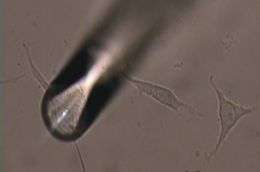The light syringe

(PhysOrg.com) -- Scientists at the University of St Andrews have developed a novel form of syringe, formed solely from light.
In a joint venture between the Schools of Physics & Astronomy and Biology, the St Andrews researchers have created a new technique that relies on a method called "photoporation".
This innovative method allows insoluble compounds such as genes and drugs to be injected into individual cells with the assistance of light. This will allow the potential detection of specific diseases and assist in the development of medication.
Professor Kishan Dholakia from the School of Physics & Astronomy and Dr Frank Gunn-Moore from the School of Biology led the work.
Professor Dholakia explained, "This method has, to date, been hampered as it was necessary to focus the laser beam to a very precise and extremely small point at the cell surface - a place hard to locate!
"However our novel technique uses a laser beam shape that does not spread: it stays narrow and elongated."
The discovery means that such 'exact focusing' is no longer necessary with the light syringe. Developed as a 'click and go' system, the approach will also be accessible to non-experts.
Dr Frank Gunn-Moore said, "The new form of laser has the ability to target any part of a cell without the need for exact focusing and is not stopped by objects placed in its way."
In a further break-through the scientists have also developed the first photoporation system that can be put on the end of a specially designed optic fibre.
The light is able to travel along a fibre the width of a human hair. This paves the way for the system to be devised for endoscopes, which are commonly used in hospitals as a way of seeing inside the body.
Dr Gunn-Moore continued, "We are very excited by these revolutionary new techniques. This method will allow us to build a machine that could be used with endoscopes. It will also allow us the potential to treat specific diseases and help in the testing of new drugs."
Provided by University of St Andrews





















